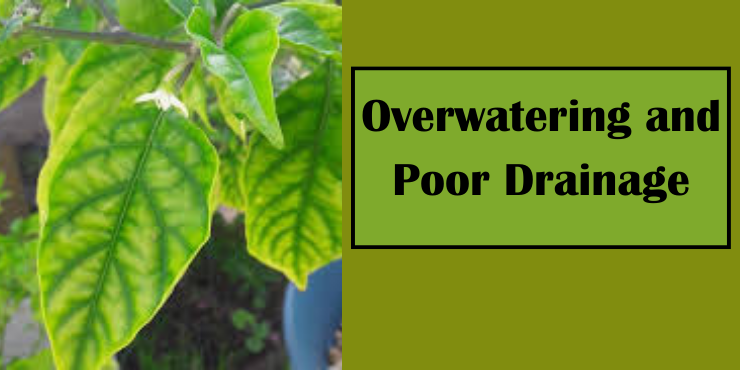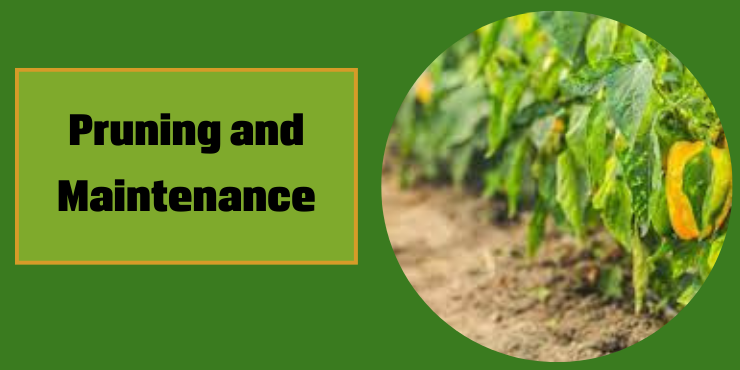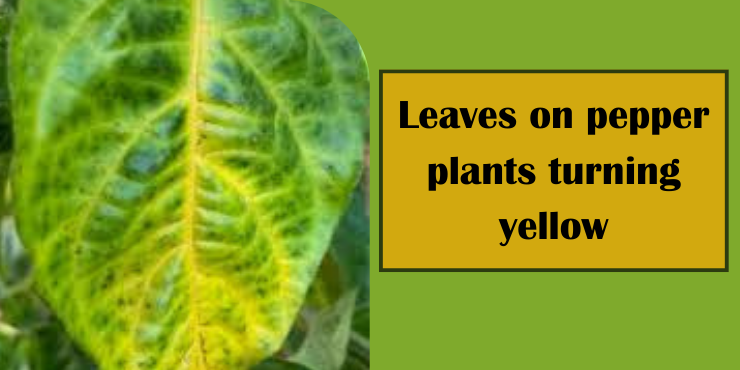Have you noticed that the Leaves on pepper plants turning yellow? If so, you are not alone. Yellowing leaves are a common problem that many gardeners experience with pepper plants. This issue can be distressing, as it can impact the overall health and productivity of your plants. However, with some understanding of the possible causes and appropriate remedies, you can effectively address this issue and restore your pepper plants to their vibrant and healthy state.
In this guide, we will explore some of the common reasons why pepper plant leaves turn yellow and provide helpful tips on how to prevent and treat this problem. So, let’s dive in and get your pepper plants back on track to flourishing green foliage and abundant harvests.
Leaves on pepper plants turning yellow
If the leaves on pepper plants turning yellow, it can be a sign of an underlying issue affecting the health of the plant. Yellowing leaves can be caused by various factors, such as nutrient deficiencies, pest infestation, overwatering, or diseases. One possible reason for yellowing leaves is a nutrient deficiency, particularly a lack of nitrogen or iron.
Nitrogen deficiency can lead to chlorosis, where the leaves lose their green color and turn yellow. Iron deficiency can also cause yellowing, typically appearing as yellowing between leaf veins. Pest infestation can also lead to yellowing leaves. Aphids, spider mites, or whiteflies can suck the sap out of the leaves, causing them to turn yellow and eventually fall off. Overwatering or poor drainage can also cause yellowing leaves.
When the roots are consistently saturated with water, they can become waterlogged and oxygen-deprived, leading to yellowing of the leaves. Plant diseases can also be a factor in the yellowing of leaves. Viruses, bacterial infections, or fungal diseases can weaken the plant and cause yellowing and wilting of the leaves. To address yellowing leaves, it is important to first identify the specific cause. This can be done by analyzing the symptoms on the leaves
Understanding the Natural Growth Cycle
It is important to remember that yellowing leaves can be a normal part of a plant’s growth and not necessarily indicate a problem. As pepper plants mature and go through their lifecycle, older leaves naturally start to yellow and drop off, making room for new growth.
Additionally, environmental factors such as temperature and sunlight can play a role in yellowing leaves. Extreme temperatures, both hot and cold, can stress pepper plants, leading to yellowing leaves. Insufficient sunlight can also cause leaves to turn yellow as plants struggle to photosynthesize and produce energy.
Nutrient deficiencies or imbalances can be another cause of yellowing leaves. Specifically, a lack of nitrogen, iron, or magnesium can result in yellowing leaves. Nitrogen deficiency often starts with older leaves, causing them to turn pale yellow, while iron deficiency may cause leaves to turn yellow between the veins. Magnesium deficiency, on the other hand, leads to yellowing and browning of leaf edges. Pests and diseases can also contribute to yellowing leaves on pepper plants. Common pests like aphids or spider mites can drain the plant’s nutrients, leading to yellowing leaves.
Nutrient Deficiencies
infections can also cause yellowing and browning of leaves. To address and prevent yellowing leaves on pepper plants, it is essential to provide optimal growing conditions. Ensure that your plants receive adequate sunlight, ideally 6-8 hours per day. Maintain consistent temperatures, avoiding extremes that can stress the plants. Regularly check the soil moisture levels and water your plants appropriately.
Overwatering can lead to root rot and nutrient deficiencies, while underwatering can cause stress and nutrient uptake issues. Strive for balanced soil moisture, allowing the top inch of soil to dry out between watering. To address nutrient deficiencies, consider fertilizing your pepper plants with a balanced fertilizer or an appropriate nutrient-specific fertilizer. Pay attention to the specific nutrient deficiencies you suspect, such as nitrogen, iron, or magnesium, and choose a fertilizer formulated to address those issues.
If you suspect pest or disease issues, inspect your plants regularly and take appropriate action, such as using organic or chemical treatments to control pests or applying appropriate fungicides to combat fungal infections. In conclusion, yellowing leaves on pepper plants can be attributed to various factors, including natural growth cycles, environmental conditions, nutrient deficiencies, pests, or diseases. By understanding the underlying causes and implementing appropriate remedies, you can successfully address this issue and ensure
Overwatering and Poor Drainage

The continued health and productivity of your pepper plants. Regular monitoring, proper water management, providing adequate sunlight, and addressing nutrient deficiencies or pest and disease issues will help prevent and resolve yellowing leaves, allowing your pepper plants to thrive and produce a bountiful harvest.
Believe it or not, too much water can be just as harmful as too little. Overwatering and poor drainage can lead to root rot, which in turn affects the plant’s ability to take up nutrients, leading to yellowing leaves. Make sure your pepper plants are in well-draining soil and that you’re following a proper watering schedule.
Pests and Diseases
If you have noticed that the leaves on your leaves on pepper plants turning yellow, it may be an indication of pests or diseases impacting their health. Pests, such as aphids or spider mites, can infest pepper plants and suck out their nutrients, causing the leaves to turn yellow. Diseases, such as bacterial or fungal infections, can also lead to yellowing of the leaves.
To address this issue, it is important to identify and eliminate the pests or diseases affecting your leaves on pepper plants turning yellow. Regularly inspect the plants for signs of infestation or infection, such as webbing, discolored spots, or distorted leaves. Treat any pests with appropriate organic or chemical insecticides, following the instructions carefully. For diseases, use fungicides specifically formulated to combat the specific infection.
Additionally, it is crucial to ensure that your pepper plants receive the proper care and conditions for healthy growth. Provide them with sufficient sunlight, about 6-8 hours a day, as well as regular watering to keep the soil moist but not waterlogged. Ensure proper drainage to prevent root rot. Proper fertilization with a balanced fertilizer can also help maintain the overall health and nutrition of the plants. By addressing pests or diseases and providing proper care, you can prevent further yellowing of the leaves and promote healthy
Improper pH Levels
One possible reason why the leaves on your pepper plants are turning yellow is improper pH levels in the soil. Pepper plants prefer slightly acidic soil with a pH level between 5.5 and 7.0. If the pH level is too high (alkaline) or too low (acidic), it can affect the plant’s ability to absorb nutrients properly, leading to yellowing leaves. To determine the pH level of your soil, you can use a soil testing kit or send a soil sample to a local extension service for analysis.
If the pH is too high or too low, you can adjust it by adding certain amendments. To lower pH (making it more acidic), you can add sulfur, peat moss, or organic matter like coffee grounds or compost. To raise pH (making it more alkaline), you can add lime or wood ash. Follow the recommended application rates based on the specific product and the size of your garden.
It is important to note that adjusting pH is a gradual process, and it may take some time for the effects to show. Monitor your plants’ progress and adjust accordingly if needed. Additionally, regular soil testing and pH monitoring will help you maintain optimal conditions for your pepper plants’ growth. In addition to improper pH levels, other factors like
Environmental Stress
Environmental stress refers to changes in the surrounding conditions that negatively impact the growth and health of plants. In the specific case of pepper plants, an indication of environmental stress is the turning yellow of their leaves. This phenomenon can occur due to a variety of factors, including excessive sunlight, extreme temperatures, poor soil quality, inadequate water supply, or exposure to chemicals or pollutants. When pepper plants are exposed to too much sunlight, their leaves can become scorched, leading to yellowing and browning.
Similarly, exposure to extremely high or low temperatures can disrupt the plant’s physiological processes and cause leaf discoloration. Poor soil quality, lacking essential nutrients or pH imbalance, can impair the plant’s ability to absorb nutrients, leading to nutrient deficiencies and subsequent yellowing of the leaves. Insufficient or excessive watering can also stress the plant, resulting in yellow leaves due to under or overhydration.
Furthermore, the presence of chemicals or pollutants in the environment can have detrimental effects on pepper plants. Chemicals, such as herbicides or pesticides, if not used correctly, can damage the plant’s leaves and disrupt its normal functioning. Similarly, exposure to air and water pollution, including heavy metals or toxins, can lead to leaf yellowing as the plant struggles to cope with the foreign substances. In order
Pruning and Maintenance

To address yellowing leaves on pepper plants, pruning and maintenance practices can be implemented. Pruning involves the removal of damaged or diseased leaves, stems, or branches, allowing the plant to focus its resources on healthy growth. This also helps prevent the spread of diseases.
Regularly inspect the pepper plants for any signs of pests or diseases, as these can also cause leaf yellowing. If any issues are detected, appropriate treatments, such as organic or chemical pest control methods, can be applied to eradicate the problem.
Final Thought:
Leaves on pepper plants turning yellow can be caused by a variety of factors, including nutrient deficiencies, pest infestation, overwatering, or diseases. To address this issue, it is important to first identify the specific cause by analyzing the symptoms and conducting appropriate tests if necessary. Once the cause is determined, the appropriate solution can be implemented, such as adjusting the soil pH, providing adequate nutrients, maintaining proper water and sunlight levels, or implementing pest control measures. Regular monitoring and preventive measures can help in maintaining the health and vitality of pepper plants, ensuring a successful harvest.
FAQs
- Q: Can I use household remedies to get rid of pests on my leaves on pepper plants turning yellow? A: While some household remedies may offer temporary relief, it’s generally recommended to use proven methods and pesticides for effective pest control.
- Q: How often should I fertilize my leaves on pepper plants turning yellow? A: Fertilize your pepper plants every 4-6 weeks during the growing season with a balanced fertilizer.
- Q: Is it normal for pepper plants to drop leaves? A: Yes, pepper plants naturally shed older leaves as new growth emerges. This is generally a normal part of their growth cycle.
- Q: Can I grow Leaves on pepper plants turning yellow indoors? A: Yes, peppers can be grown indoors, provided they receive adequate light and care.
- Q: What is the best way to prevent overwatering? A: Ensure proper drainage in your pots or garden beds and allow the top inch of soil to dry out before watering again.

Pingback: Leaf curl on pepper plants- Causes and Solutions - Quotes Tutor